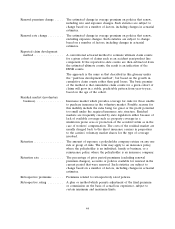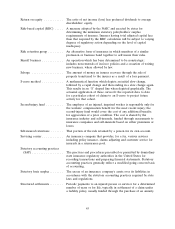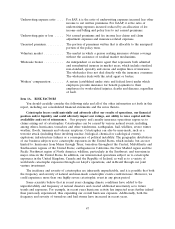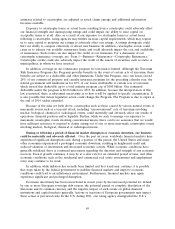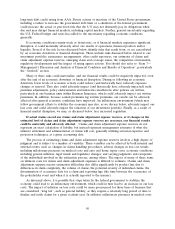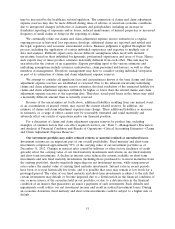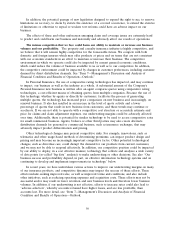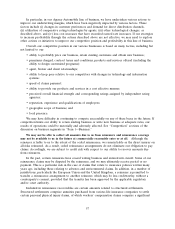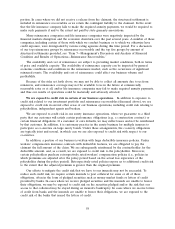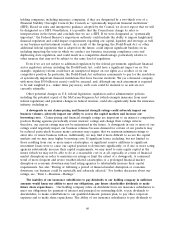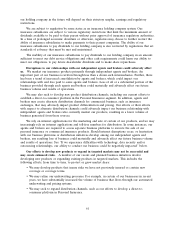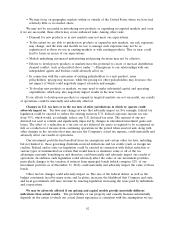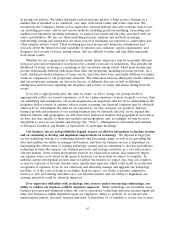Travelers 2012 Annual Report Download - page 65
Download and view the complete annual report
Please find page 65 of the 2012 Travelers annual report below. You can navigate through the pages in the report by either clicking on the pages listed below, or by using the keyword search tool below to find specific information within the annual report.Our investment portfolio is also subject to increased valuation uncertainties when investment
markets are illiquid. The valuation of investments is more subjective when markets are illiquid, thereby
increasing the risk that the estimated fair value (i.e., the carrying amount) of the portion of the
investment portfolio that is carried at fair value as reflected in our financial statements is not reflective
of prices at which actual transactions could occur.
Given that economic and market conditions are highly uncertain, we may, depending on
circumstances in the future, make changes to the mix of investments in our investment portfolio. These
changes may impact the duration, volatility and risk of our investment portfolio.
Because of the risks set forth above, the value of our investment portfolio could decrease, we
could experience reduced net investment income and we could experience realized and/or unrealized
investment losses, which could materially and adversely affect our results of operations, financial
position and/or liquidity.
Our business could be harmed because of our potential exposure to asbestos and environmental
claims and related litigation.
With regard to asbestos claims, we have received and continue to receive a significant number of
asbestos claims from policyholders (including others seeking coverage under a policy). Factors
underlying these claim filings include intensive advertising by lawyers seeking asbestos claimants and
the continued focus by plaintiffs on previously peripheral defendants. The focus on these defendants is
primarily the result of the number of traditional asbestos defendants who have sought bankruptcy
protection in previous years. The bankruptcy of many traditional defendants has prompted plaintiffs to
aggressively seek out potential new defendants and has caused increased settlement demands against
those policyholders who are not in bankruptcy but who remain in the tort system. Currently, in many
jurisdictions, those who allege very serious injury and who can present credible medical evidence of
their injuries are receiving priority trial settings in the courts, while those who have not shown any
credible disease manifestation are having their hearing dates delayed or placed on an inactive docket.
This trend of prioritizing claims involving credible evidence of injuries, along with the focus on
previously peripheral defendants, contributes to the claims and claim adjustment expense payments
experienced by us.
We also continue to be involved in coverage litigation concerning a number of policyholders, some
of whom have filed for bankruptcy, who in some instances have asserted that all or a portion of their
asbestos-related claims are not subject to aggregate limits on coverage. In these instances, policyholders
also may assert that each individual bodily injury claim should be treated as a separate occurrence
under the policy. It is difficult to predict whether these policyholders will be successful on both issues.
To the extent both issues are resolved in a policyholder’s favor and our other defenses are not
successful, our coverage obligations under the policies at issue would be materially increased and
bounded only by the applicable per-occurrence limits and the number of asbestos bodily injury claims
against the policyholders. Accordingly, although we have seen a moderation in the overall risk
associated with these lawsuits, it remains difficult to predict the ultimate cost of these claims.
Further, in addition to asbestos claims against policyholders, proceedings have been launched
directly against insurers, including us, by individuals challenging insurers’ conduct with respect to the
handling of past asbestos claims and by individuals seeking damages arising from alleged asbestos-
related bodily injuries. It is possible that the filing of other direct actions against insurers, including us,
could be made in the future. It is not possible to predict the outcome of these proceedings, including
whether the plaintiffs will be able to sustain these actions against insurers based on novel legal theories
of liability.
With regard to environmental claims, we have received and continue to receive claims from
policyholders who allege that they are liable for injury or damage arising out of their alleged
disposition of toxic substances. Mostly, these claims are due to various legislative as well as regulatory
53



